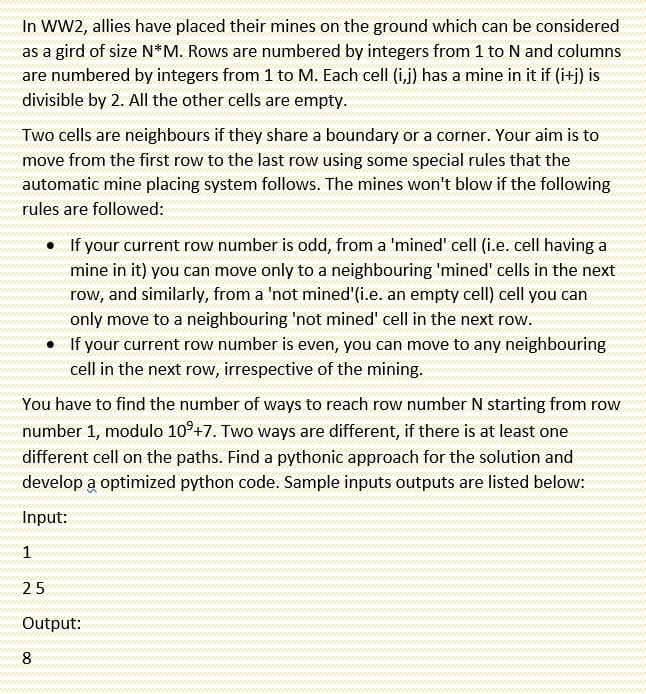In WW2, allies have placed their mines on the ground which can be considered as a gird of size N*M. Rows are numbered by integers from 1 to N and columns are numbered by integers from 1 to M. Each cell (i,j) has a mine in it if (itj) is divisible by 2. All the other cells are empty. Two cells are neighbours if they share a boundary or a corner. Your aim is to move from the first row to the last row using some special rules that the automatic mine placing system follows. The mines won't blow if the following rules are followed:
In WW2, allies have placed their mines on the ground which can be considered as a gird of size N*M. Rows are numbered by integers from 1 to N and columns are numbered by integers from 1 to M. Each cell (i,j) has a mine in it if (itj) is divisible by 2. All the other cells are empty. Two cells are neighbours if they share a boundary or a corner. Your aim is to move from the first row to the last row using some special rules that the automatic mine placing system follows. The mines won't blow if the following rules are followed:
Computer Networking: A Top-Down Approach (7th Edition)
7th Edition
ISBN:9780133594140
Author:James Kurose, Keith Ross
Publisher:James Kurose, Keith Ross
Chapter1: Computer Networks And The Internet
Section: Chapter Questions
Problem R1RQ: What is the difference between a host and an end system? List several different types of end...
Related questions
Question
Computer Engineering lab

Transcribed Image Text:In WW2, allies have placed their mines on the ground which can be considered
as a gird of size N*M. Rows are numbered by integers from 1 to N and columns
are numbered by integers from 1 to M. Each cell (i,j) has a mine in it if (i+j) is
divisible by 2. All the other cells are empty.
Two cells are neighbours if they share a boundary or a corner. Your aim is to
move from the first row to the last row using some special rules that the
automatic mine placing system follows. The mines won't blow if the following
rules are followed:
• If your current row number is odd, from a 'mined' cell (i.e. cell having a
mine in it) you can move only to a neighbouring 'mined' cells in the next
row, and similarly, from a 'not mined'(i.e. an empty cell) cell you can
only move to a neighbouring 'not mined' cell in the next row.
• If your current row number is even, you can move to any neighbouring
cell in the next row, irrespective of the mining.
You have to find the number of ways to reach row number N starting from row
number 1, modulo 10°+7. Two ways are different, if there is at least one
different cell on the paths. Find a pythonic approach for the solution and
develop a optimized python code. Sample inputs outputs are listed below:
Input:
1
25
Output:
8
Expert Solution
This question has been solved!
Explore an expertly crafted, step-by-step solution for a thorough understanding of key concepts.
Step by step
Solved in 3 steps with 2 images

Recommended textbooks for you

Computer Networking: A Top-Down Approach (7th Edi…
Computer Engineering
ISBN:
9780133594140
Author:
James Kurose, Keith Ross
Publisher:
PEARSON

Computer Organization and Design MIPS Edition, Fi…
Computer Engineering
ISBN:
9780124077263
Author:
David A. Patterson, John L. Hennessy
Publisher:
Elsevier Science

Network+ Guide to Networks (MindTap Course List)
Computer Engineering
ISBN:
9781337569330
Author:
Jill West, Tamara Dean, Jean Andrews
Publisher:
Cengage Learning

Computer Networking: A Top-Down Approach (7th Edi…
Computer Engineering
ISBN:
9780133594140
Author:
James Kurose, Keith Ross
Publisher:
PEARSON

Computer Organization and Design MIPS Edition, Fi…
Computer Engineering
ISBN:
9780124077263
Author:
David A. Patterson, John L. Hennessy
Publisher:
Elsevier Science

Network+ Guide to Networks (MindTap Course List)
Computer Engineering
ISBN:
9781337569330
Author:
Jill West, Tamara Dean, Jean Andrews
Publisher:
Cengage Learning

Concepts of Database Management
Computer Engineering
ISBN:
9781337093422
Author:
Joy L. Starks, Philip J. Pratt, Mary Z. Last
Publisher:
Cengage Learning

Prelude to Programming
Computer Engineering
ISBN:
9780133750423
Author:
VENIT, Stewart
Publisher:
Pearson Education

Sc Business Data Communications and Networking, T…
Computer Engineering
ISBN:
9781119368830
Author:
FITZGERALD
Publisher:
WILEY